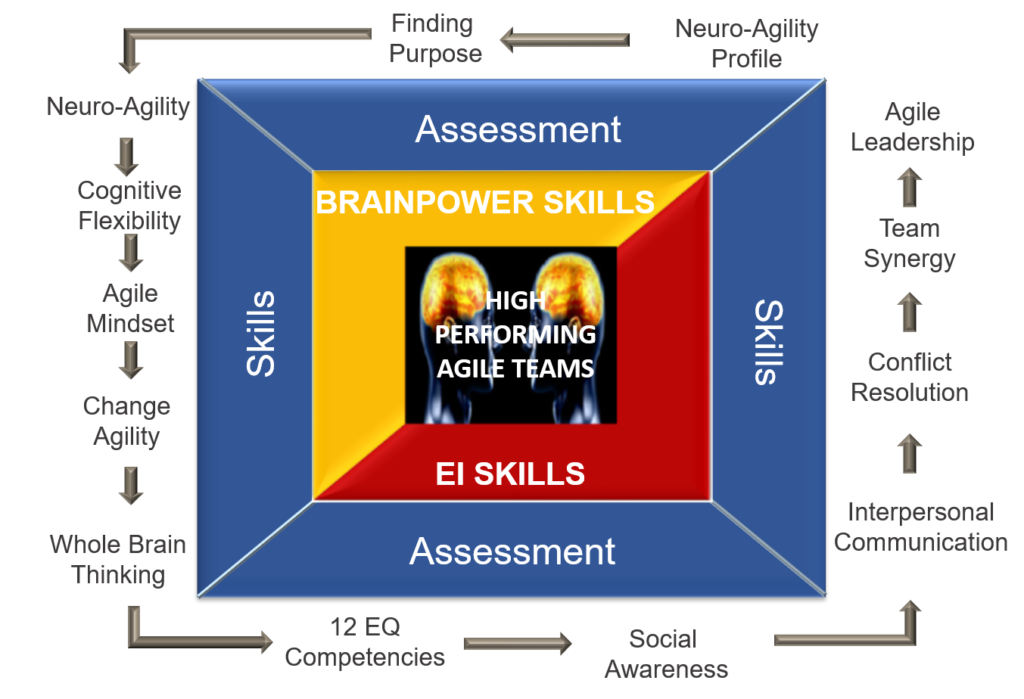Case Study: Developing Agile Leaders and Teams
Background:
- An international logistics company recorded a 113 million loss in three cross-functional divisions over one financial year. As a result, no 13th check or performance bonuses could be paid.
- An investigation indicated that executive leaders and HODs were mainly responsible for mistakes, errors, and incorrect decisions that led to losses.
Purpose of case study
- An investigation was launched to understand why losses occurred.
- How to rectify and prevent this scenario from occurring again.
The following root causes were identified for losses:
- Human errors were caused by egotistical mindsets, poor decision making and a lack of attention to detail
2. Lack of taking accountability:
- Mirroring potential mistakes away from themselves or departments to others
- Lack of authenticity and transparency
3. Incorrect decision-making due to lack of agile mindsets and cognitive flexibility:
- A culture of task matters more than people
- Lack of growth mindset
- Silo thinking in departments
- HODs and managers making incorrect assumptions without verifying
- Strong egotistical mindsets
4. Insufficient interpersonal and leadership agility skills:
- Lack of interpersonal communication between executive managers
- Insufficient feedback
- Destructive interpersonal conflict
- Lack of unforced team synergy due to lack of trust

Actions taken
- Individual assessments, debriefings, and PDPs for each participant.
- A NAP™ Advanced+ assessment was compiled of all executive leaders to measure the elements that promote their brain performance, mental flexibility, and the neuro-design elements that impact their risk for error and communication styles. Each executive received a 29-page personal development NAP report, a face-to-face debriefing, and compiled a personal development plan (PDP) to improve their brain fitness and mental flexibility.
- Subsequently, a 12 Emotional Intelligence Competencies Profile™ was compiled of all executive leaders and senior managers to determine their emotional intelligence competencies. Each executive received a 14-page personal development EI report, and a face-to-face debriefing, and compiled a personal development plan to improve their emotional intelligence skill set.
2. Team assessments and debriefings
- A NAP™ Team Agility Profile and development plan was compiled and discussed with the executive leadership team to measure the mental flexibility and neuro-design elements that impact team agility, their risk for error, and communication styles.
- The CEO received a NAP™ Team Agility Report to better understand:
- – Who is on the team,
- – How to manage them towards their natural strengths,
- – Identify which gaps to close in the strategic thinking process,
- – Their unique neurological communication styles
- – How to reduce the executive team’s potential risk for error.
- Subsequently, an EI Team Profile was compiled and discussed with the executive leadership team to measure the emotional intelligence elements that promote high-performing teams.
- 3. A blended approach to training was followed with participants
- The following learning interventions and solutions were offered:
- – 1 Day live contact session per month for 1 year
- – All participants completed the online Brain Agility Booster and the High Achiever Emotional Intelligence Program for Agile Leaders.
- – Each participant received 12 coaching sessions over 1 year – 1 session per month.
- – All participants had at least 1 contact session per month after each module to discuss how their learning could be practically applied and implemented in their business.
- Post evaluations of their NAP and Emotional Intelligence Competencies profiles were done 1 a year later to measure their PDP progress.
- The company internally evaluated all participants’ performance and correlated it to the post evaluations of the NAP and emotional intelligence assessments.




Summary of human skills needed to address root causes:
- Complex problem solving
- Critical and creative (whole brain) thinking
- Accurate decision-making and risk-taking
- Interpersonal communication and conflict resolution
- Team synergy, trust, and collaboration
- Interpersonal skills
- Social awareness skills
- Leadership Agility
- Cognitive flexibility
- Agile and growth mindset
- Change agility
Proposed skills development interventions
- Strengthen cross-functional communication and interaction that will resolve conflict and drive business results
2. Develop brainpower skills like:
- Complex problem solving
- Critical/analytical and creative/strategic thinking
- Cognitive flexibility
- Agile mindset
- Decision making
3. Develop emotional intelligence skills like:
- Effective communication and conflict resolution
- Trust, collaboration, and team cohesion
- Leadership agility
4. Minimize the risk for error and mistakes through skills like stress and fatigue management



Skills development process for the leadership team:

Summary of results achieved:
- 13.3% increase in brain fitness optimization
- 9.3% increase in cognitive flexibility
- 12.4% increase in overall brain agility
- 12.8% increase in overall emotional intelligence
- 34% increase in performance = 4 promotions
- Statistics above correlated to improved business performance
- Employees received a 13th cheque as well as additional performance bonuses for some
- No significant losses due to human error
- Significant profits reported
- 3 additional business units acquired
ROI impact on the company
- 100% of respondents stated that knowing their neuro-design and potential risk for error helped them in leading more effectively and reducing their risk for errors and mistakes
2. Improvement in NAP and EI scores correlated to:
- Improved business performance
- Promotions
- Fewer errors, and mistakes
- Increased social cohesion and team agility
Key takeaways:
- This case study amplifies the fact that brain power and emotional intelligence skill sets are mandatory for individual, team, and organizational success.
- Agility, brainpower and emotional intelligence skill sets, psychological safety, and values like trust, accountability, collaboration, and purpose are the drivers that enable high-performing, agile teams to out-perform their competition.
- Agile leaders who create agile, high-performing teams are the secret ingredient for organizational success.
Related Topics
Previous slide
Next slide
